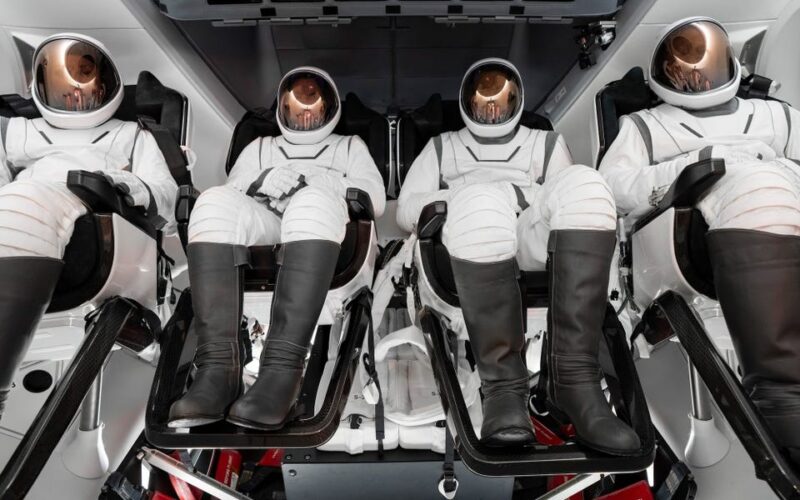Four private citizens — none of them professional astronauts — plan to climb aboard SpaceX’s Crew Dragon spaceship and roar into orbit atop a Falcon 9 rocket.
SpaceX is also taking the opportunity to advance Elon Musk’s greatest ambition: sending people to Mars.
This isn’t the space-tourist joyride you might imagine. The Polaris Dawn crew plans to conduct experiments and test technologies for Mars, including the first-ever attempt at a new spacewalk method.
“We’re really starting to push frontiers with the private sector and learning new things that we would not be able to learn by staying in the risk-free environment here on Earth,” Bill Gerstenmaier, who is SpaceX’s vice president of build and flight reliability, said in a briefing on August 19.
“It’s time to go out, it’s time to explore, it’s time to do these big things and move forward,” Gerstenmaier added.
Polaris Dawn plans to fly through a radiation belt
Along with Isaacman, the crew includes a former US Air Force pilot named Scott Poteet and two SpaceX engineers, Sarah Gillis and Anna Menon.
SpaceX
They’re scheduled to spend about five days in space, soaring further from Earth than anybody has gone since the Apollo era more than 50 years ago.
As they travel up to 1,400 kilometers (870 miles) from Earth’s surface, they should pass through the Van Allen radiation belts, which are two donuts of intense radiation surrounding Earth.
NASA Goddard Space Flight Center/Scientific Visualization Studio
They plan to study how that environment affects their bodies since future missions to Mars would expose passengers to immense amounts of space radiation for months.
A first-of-its-kind spacewalk plan
On day three, if everything goes according to plan, they’ll do a spacewalk. About 700 kilometers (435 miles) above Earth, the crew plans to don a set of new spacesuits, open the Crew Dragon’s hatch, and send Isaacman and Gillis into space on umbilical cables, each of them keeping contact with handholds on the spaceship.
Because Dragon has no airlock, this will depressurize the spacecraft’s cabin and expose its entire interior to the void.
Polaris via X
A Dragon spaceship has never been opened up to the vacuum of space like that.
“You are taking on a lot of risk at that point,” Isaacman said, adding that he thought SpaceX had mitigated the risks well through testing and spaceship upgrades.
He said the spacewalk was the main focus of the mission preparations, almost to the point that he worried about being “way too focused” on it. SpaceX also subjected every part of the mission to “paranoia reviews,” starting over to double-check everything, he said.
When astronauts conduct spacewalks from the space station, they do a “pre-breathe” process: They breathe pure oxygen for a few hours to pull nitrogen out of their bloodstream. Otherwise, the decrease in air pressure from the spacewalk could cause the nitrogen to form bubbles in their blood and give them a dangerous condition called the “bends.”
Polaris Dawn also plans to do a pre-breathe, but stretch it over 48 hours as they slowly depressurize the cabin. They’ve already practiced this in a two-day simulation on the ground.
Polaris Program / John Kraus
“I like the plan,” Abhi Tripathi, a former Dragon mission director at SpaceX, who now directs mission operations at UC Berkeley’s Space Sciences Laboratory, told BI in an email. “It’s a rational and incremental step, partially paid for by a private individual.”
He added that Crew Dragon was designed “from the beginning” to withstand unplanned depressurization events and that he doesn’t see “any special risks.”
New SpaceX spacesuits
A major goal of the spacewalk is to test out SpaceX’s first extravehicular spacesuits, which use new textiles and joint designs for increased mobility. The suits also feature a “heads-up” display in the mask, which shows the wearer real-time information about the suit’s internal pressure, temperature, and humidity.
“You’re throwing away all the safety of your vehicle,” Isaacman said of the spacewalk.
“Your suit becomes your spaceship,” he added.
Crew Dragon has a strong spaceflight record, except for the toilet
Dragon spaceships have flown eight crews of astronauts to and from the space station for NASA, as well as four private missions.
The vehicle’s first private mission — which was also the world’s first all-tourist spaceflight — was also sponsored and led by Isaacman. That flight, called Inspiration4, carried its four passengers through Earth’s orbit for three days.
It went smoothly, except for a toilet malfunction aboard Dragon. A tube carrying urine broke loose in a compartment beneath the spaceship’s cabin floor.
The pee didn’t make it into the cabin where the passengers were living. Other than fixing a toilet system fan that set off an alarm, the crew said they didn’t notice the contamination until they’d landed.
Isaacman and his new Polaris Dawn crew are flying on that same spaceship.
Isaacman’s Polaris program plans to fly the first people on Starship
This is just the first mission of SpaceX’s and Isaacman’s Polaris program. The project has not yet announced details for its second mission.
The program’s third mission, however, is set to be the first crewed flight of SpaceX’s gargantuan Starship. That’s the workhorse rocketship that Musk plans to one day use to ferry a million people to Mars.
PATRICK T. FALLON/Getty Images
Starship, which stands taller than the Statue of Liberty, flew to space and returned in one piece for the first time in June. It has many more test flights ahead before SpaceX plans to put a Polaris crew on board.
Source link
lol

